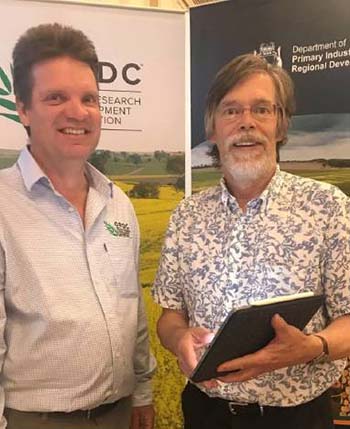New technology is now available to help growers make informed management decisions before spraying their canola crops for the fungal disease sclerotinia.
With fungicides being one of the most expensive inputs throughout the life of a canola crop, growers need to be armed with all available information to help them make decisions that will provide the most profitable outcome at the end of the season.
The new GRDC-invested SclerotiniaCM app, available for this season, has been designed by WA Department of Primary Industries and Regional Development (DPIRD) researchers.
It will provide growers with greater confidence when making significant financial decisions about fungicide during the flowering stage of a canola crop.
 GRDC Western Region Panel chair Darrin Lee, left, launches the new SclerotiniaCM app with DPIRD senior research officer Dr Art Diggle at the WA GRDC Grains Research Updates earlier in the year. Photo: Jo Fulwood
GRDC Western Region Panel chair Darrin Lee, left, launches the new SclerotiniaCM app with DPIRD senior research officer Dr Art Diggle at the WA GRDC Grains Research Updates earlier in the year. Photo: Jo Fulwood
DPIRD senior research officer Dr Art Diggle says the app is intended to support a conversation in the paddock between the grower and their adviser.
He says it can provide probability outcomes for individual decisions in both data and graph formats.
He says the tablet-based app, suitable for both iOS and Android, allows growers to input site and season-specific information about their canola crops to produce a predicted financial outcome.
"There are a number of controls that you can change in the app to allow the outcomes to be site specific,” he says.
“These factors include factors such as soil type, target yield and grain prices, to name a few.
"Importantly, the app needs to know the history of the paddock.”
This includes:
- how many broadleaf crops have been grown in the last 10 years
- the disease history of the paddock
- how prevalent sclerotinia has been in the area in recent times.
The app will also need to know whether the paddock has already been sprayed for the disease.
It also requires weather information, including about recent, current and predicted events.
"For example, (it needs to know) how many times it has rained in the past three weeks and how many wet days are predicted in the coming three weeks," Dr Diggle says.

An example of the probability graph outcome produced by the SclerotiniaCM app.
"This information will have a bearing on how prevalent sclerotinia is likely to be in your canola crop.”
This, in turn, will help determine how worthwhile it will be to your end yield result to spray the disease.
The SclerotiniaCM app will provide a graphical outcome showing the best and worst-possible financial outcomes from a spray decision.
This includes the most likely financial outcome from any decision made.
It will also provide comparison data on profit outcomes if a grower decides against spraying for the disease.
Dr Diggle says the app will help growers better understand disease in canola crops and potential outcomes.
He says there are several high-cost management items in growing grain.
“Fertiliser and control of weeds are two of the biggest that growers are dealing with," he says.
"Disease control is the next big one, but it's in this area where growers may not be as clear on what they should do, which is where this new app will play a major role for the industry."
In some cases, Dr Diggle says, growers could be over-spending on fungicide to insure against yield loss.
"Our feedback is that, if a grower can protect their yield against an unknown amount of yield loss with a known upfront spend, then they will do this, even though it may not be the most profitable outcome," he says.
"We are hoping this app will help growers take out the guess work from these major decisions."
The SclerotiniaCM app is currently only available for download on to a tablet (not a phone).
But Dr Diggle says this may change in the future.
Growers can access the free app by clicking on the app store link from an iPad, or the Google play link from an Android tablet.
GRDC has also produced a video outlining sclerotinia management tactics, that are focused on WA, and a podcast about breeding efforts to develop resistant varieties to this disease.
A guide to planning for the 2019 season in WA for sclerotinia disease in canola can be found on the GRDC website.
Some of the key in-season management tips outlined in the WA guide include:
- applying a single foliar fungicide at 30-50 per cent bloom if needed
- using the SclerotiniaCM app for assistance with spray timing decisions
- avoiding late spray applications, after 50 per cent bloom, as these are typically not economical
- following fungicide label instructions
- using only registered foliar fungicides
- using two fungicide applications only in an extended wet season when disease risk remains high into spring and the crop has high yield potential
- considered fungicide in wide row spacing (44cm) if needed due to seasonal conditions
- using a foliar fungicide for basal infection prior to flowering, at or before 30 per cent bloom, if needed.
More information: Dr Art Diggle, DPIRD, art.diggle@dpird.wa.gov.au

























































